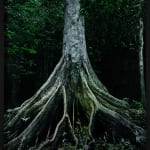

Marshmallow Laser Feast
55 1/8 x 31 1/2 in
The Capinuri Tree (Maquira coriacea) and the Amazon Rainforest
In 2020/21, the MLF team carried out ecological surveys of the capinuri tree (Maquira coriacea) (4° 2' 39.15" S 70° 5' 2.45" W), gathering volumetric data and ambisonic field recordings as part of our ongoing digital preservation process for endangered ecosystems and the species that inhabit these fragile biomes.
Large-buttressed and smooth-barked, capinuri trees (Maquira coriacea) grow to 45 metres (150 feet) in height, reaching above the canopy of their native rainforest. These towering emergent trees provide a habitat for innumerable plants and animals, who find shelter and nourishment amid their spreading branches and foliage.
The Earth’s oldest living ecosystems, rainforests hold a deep wisdom that underpins their complex systems and tightly interlinked carbon, oxygen, and water cycles, which enable life all over the planet. In fact, the Amazon rainforest carries one-fifth of all the freshwater released into the oceans every day, and has been called “the lungs of the planet” because of the huge proportion of the world’s oxygen that its trees produce.
These trees also act as powerful weather-makers, pulling water up from the soil and releasing it into the sky. By producing cloud condensation nuclei, or “cloud seeds”, they form their own clouds that cover the forest, poised to drench the vibrant ecosystem below with life-sustaining water. And they have a ripple effect on global weather systems, too: as they influence the movement of tropical low air pressure, they fuel the giant wheels of air that spin weather systems around the globe.
In growing forests, trees use the sugars produced from carbon dioxide and light energy as building blocks, effectively acting as natural carbon sinks that pull carbon dioxide from the air and trap it in their trunks, leaves, and soil. Ecologists estimate that the Amazon absorbs around 600 million tonnes of carbon per year and is presently storing over 150 billion tonnes of carbon – roughly ten years of global fossil fuel emissions.
Meanwhile, in the soil below lies an intricate network of mycorrhiza – symbiotic associations between plant roots and fungi with a 400-million-year legacy. This fine, filamentous meshwork transmits water, nutrients, and chemical signals from plant to plant, defends plants from pathogens, and filters toxins from the soil. In Breathing with the Forest, digitised projections of this network and the movement of the trees’ xylem and phloem tubes let us see inside the forest’s hidden pathways, offering a visual experience of the rhythmic interchange that keeps the forest alive – and which we participate in through our breath.
Therein lies the direct and irrefutable continuity between our bodies and this mighty forest. Every breath we take – every sip of water – is connected through global cycles to the Amazon rainforest. Breathing with the Forest makes this continuity tangible, offering a humbling reminder as a takeaway: our every living moment is supported by the life-giving action of these giant, gentle trees.
As the climate warms and the dual forces of deforestation and land degradation shrink the Amazon, the forest’s ability to sequester atmospheric carbon diminishes rapidly. When forests are chopped down or catch on fire, they become a net carbon source, adding carbon dioxide back to the atmosphere. Accelerating degradation and global climate change have introduced the risk that the Amazon will begin to emit more carbon dioxide than it is able to store. Protecting the Earth’s rainforests, then, means preserving the rich habitat of the species that inhabit them – but it also means preserving key mechanisms of planetary resilience, which protect all living things, all over our shared biosphere.


